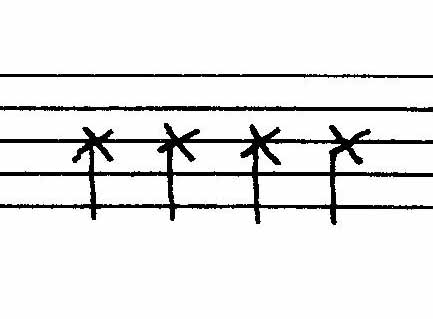Blocked Buzzing
Blocked buzzing is a bit of an unorthodox tool that I use in rehabilitation and a
technique which is discussed in all of my books. In rehabilitation,
blocked buzzing is utilized exclusively as an analytical tool; however,
it can also be used as a warm up, to get into shape, or to stay in shape while on vacation.
This is how to block buzz:
Close the end of your mouthpiece completely with
a finger. Put your mouthpiece up to your lips exactly as though you
were going to buzz a midrange note. Begin blowing by tonguing
the note. Blow
with a constant mezzo forte stream of air. (There should be
absolutely no sound or air leakage from your lips or mouthpiece. You
are just blowing silently against the resistance.)
Notice how firm and controlled your entire embouchure is and how
your chin stretches down with considerable energy as you blow.
Tongue a few notes with your mouthpiece blocked, and observe how
still your face and throat are and how well your air works.
If you are having embouchure and playing
issues, the structure your face generates to block buzz is how your embouchure functioned prior to the
onset of your problem. Embouchures that have
developed overuse-related dysfunction deprogram themselves to set
with this degree muscle energy and control. In blocked
buzzing, even the most dysfunctional of embouchures configures
mechanically correctly, and an injured player does not feel
mouthpiece pressure, lip pain, or the degree of facial fatigue that
he experiences in playing.
Let’s do that again.
Block buzz in slow motion, and pay close attention to how your
embouchure physically prepares and sets itself. Without
thought, your facial muscles automatically configure to blow against
the resistance with an intense, balanced, controlled structure.
The normal level of embouchure stability generated by a healthy
embouchure in playing is comparable to that generated naturally by
the embouchure for blocked buzzing.
Try blocked buzzing four measures of a
midrange note mezzo forte, tonguing legato slowly. When you block buzz, start a note as you do when you play,
with a TUH or
DUH.

Do this one more time,
and notice that when you block buzz, there is no movement in your
face or throat when you start a note and when you tongue. You
can also feel how controlled your air column is, how your chin
remains firm and stretched, and how firm and anchored the corners of
your mouth are. This is especially important for players
having embouchure problems to understand.
When your embouchure sets to block buzz, it automatically configures
with a firm, intensely controlled structure. There is no
discomfort felt in the embouchure in blocked buzzing because the
facial structure is already totally set when the mouthpiece meets the
lips. When an embouchure feels pain and weakness, as it
prepare to play, it instinctively winces with the initial attack.
The way this translates in playing is a very subtle flex of the
chin--a tiny release of the firmness of the structure of the
embouchure. It's like any anticipatory reaction to discomfort.
Your body is expecting pain, so it sets a weak, painful embouchure
that way. This is the underlying cause of ever embouchure
dilemma and is
the mechanical behavior any player dealing with playing problems has to be aware of and on sentry to stop.
You can create your own blocked buzzing routine for exercise;
however, I use blocked buzzing in Broken Embouchures and
Embouchure
Rehabilitation, exclusively as an analytical tool, not blowing for
exercise.
There is an expanded blocked buzzing routine in the 2014 edition
of Embouchure Rehabilitation.

Connect With Us